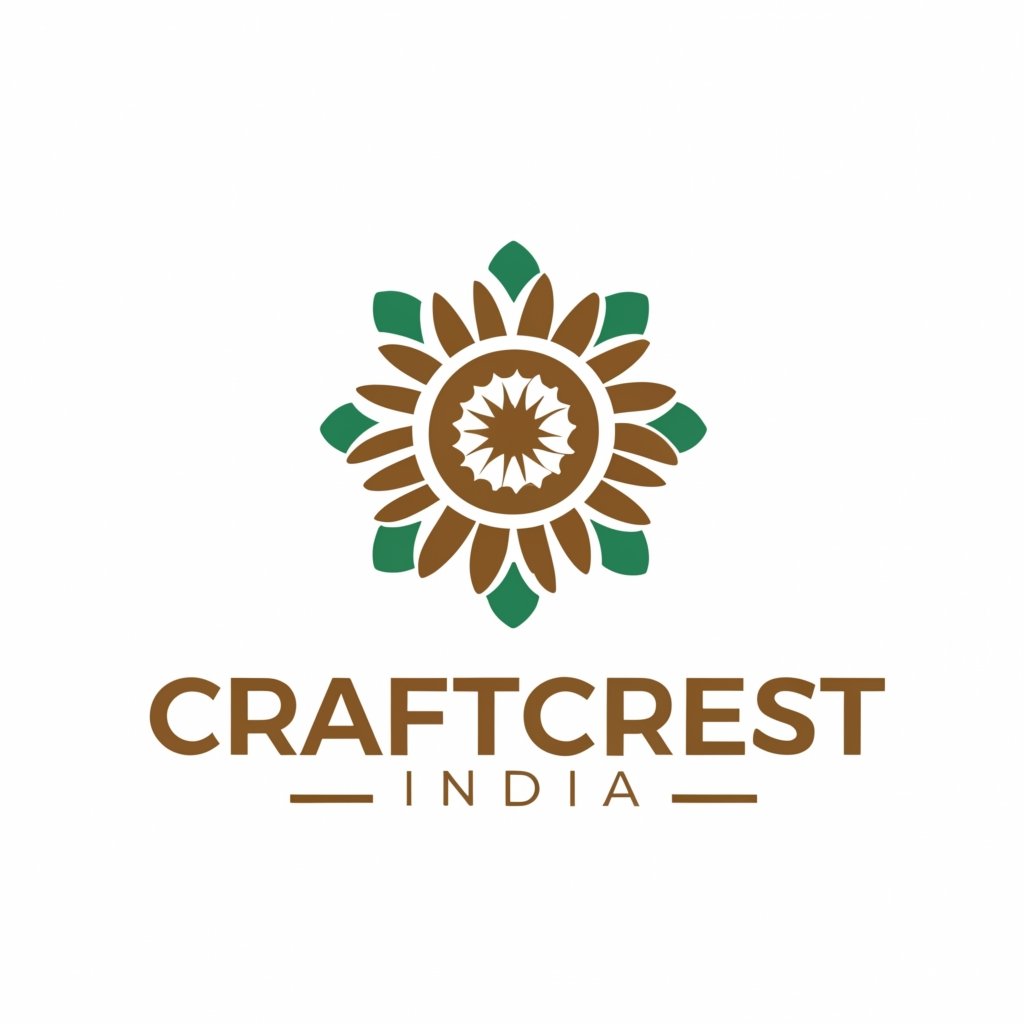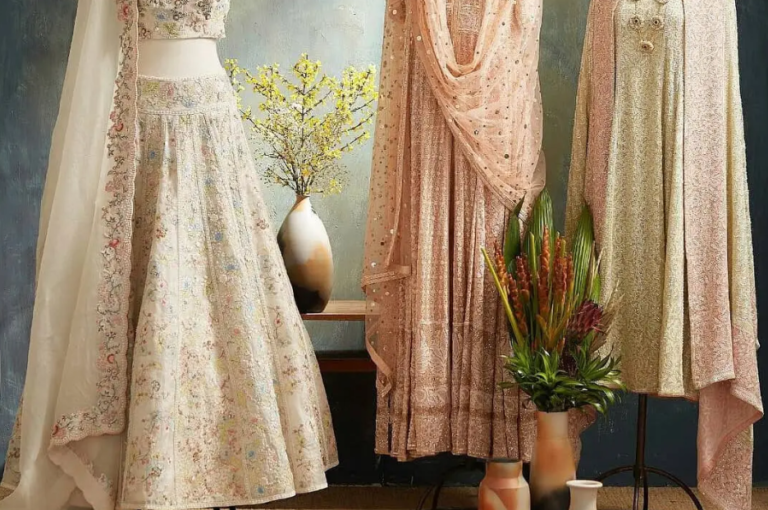
Chikankari, a delicate and intricate form of embroidery, has adorned garments for centuries, epitomizing the essence of elegance and grace. Originating from the heartlands of India, particularly Lucknow, Chikankari reflects the rich cultural heritage of the region. With nearly 90% of its work being done by women professionally, the art continues to empower the Indian women community in their journey of financial independence. In this exploration, we delve into the techniques and stitches that make it a cherished art form.
TRACING THE ROOTS & LEGACY
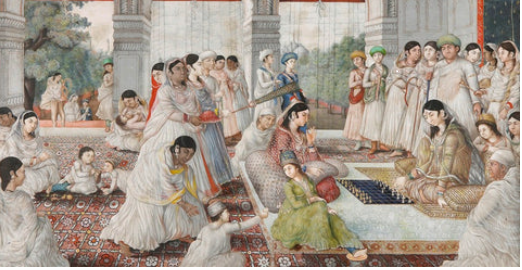
The word “Chikan” steps from a Persian word derived from the Chic, which referred to the “Jali” work done on marble or wood. The art is also well-known as “shadow work” or “white embroidery work”, traditionally practiced in Lucknow and its surroundings.
Chikankari traces its origins to the Mughal era, believed to have been introduced by Nur Jehan, the wife of Emperor Jahangir. Over time, it flourished under royal patronage and evolved into a symbol of refinement and sophistication. They started the work of embroidery on muslin and other fine cottons with multiple stitches. Today, this work is done on cotton, wool, chiffon, crepe, organza and silk clothes using mostly white threads in its most authentic form but at times also in different color threads.
In December 2008, Geographical Indication Registry (GIR) accorded Geographical Indication (GI) status for chikankari, which recognized Lucknow as an exclusive hub of chikankari.
RAW MATERIALS FOR CHIKANKARI
- Base fabrics like cotton, silk, chiffon, crepe, georgette, wool, organza, chiffon.
- Traditionally, embroidery threads are made of cotton, but on occasion, wool, silver zari, and golden zari are also used.
- Additional embellishments may include beads, sequins, and mirrors to enhance the embroidery
- The printing process uses the color indigo.
- River water is used to wash the clothes to clear the printing marks.
- For cotton clothing, starch is used to create stiffness.
TOOLS USED IN CHIKANKARI
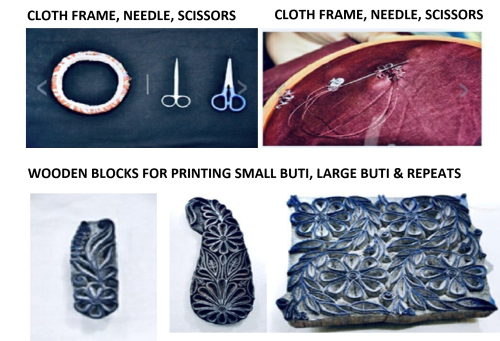
- Fine Needle called ‘sulka’ or ‘salma’
- A circular shaped frame made of wood and cloth, to hold the base fabric as it obtains tautness.
- Wooden blocks are used to print the design on plain cloth.
- A rectangular wooden table used as support during the printing process.
- Containers for washing the cloth after completion of stitching work.
SIX STEPS THAT CREATE THE MAGIC CALLED THE CHIKANKARI GARMENT
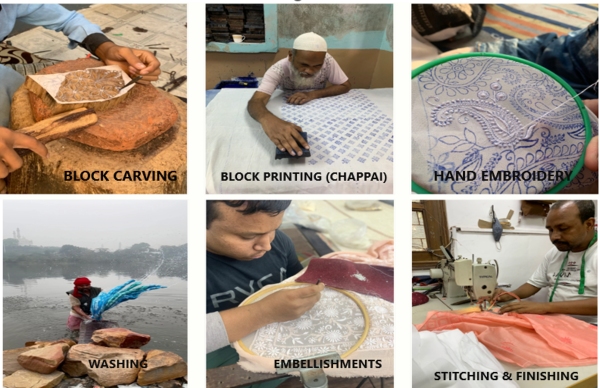
- BLOCK CARVING: Skilled artisans carve designs onto wooden blocks using chiselling tools, an age-old craft passed through generations.
- BLOCK PRINTING (CHAPPAI): Centuries-old wooden blocks are dipped in indigo, amber/gum, and water solution to pick up pigment for hand block printing on fabric.
- HAND EMBROIDERY: Karigar women embroider Chikankari stitches following block imprints. We aim to showcase a wide range of stitches, including intricate ones mastered by skilled artisans.
- WASHING: Traditional washing methods at Gomti Ghat remain integral. Secret formulas for washing off Chikankari indigo are passed down from father to son.
- EMBELLISHMENTS: Mukaish embellishment, popular in the Awadh region, involves delicately adding metal strips to fabric for a knotted finish. Other popular embellishments include Pearl work and Cut Dana.
- STITCHING AND FINISHING: Skilled tailors stitch and quality-check each garment post-wash before packaging and shipping.
MOTIFS THAT INSPIRE CHIKANKARI ART
Chikankari, influenced by Persian art, predominantly features floral motifs alongside stems and leaves. This embroidery style encompasses diverse elements, including Paisley motifs resembling beans, palm leaves, and grass stalks. Additionally, it incorporates bird and animal motifs like peacocks and butterflies, along with geometric and stylized patterns. This rich variety offers artists endless creative possibilities. The inspiration for Chikankari motifs is multifaceted, drawing from natural beauty, cultural heritage, history, and individual creativity. Each motif holds its unique significance, adding to the timeless charm of Chikankari embroidery.
EXPLORING DIFFERENT EMBROIDERY STYLES IN CHIKANKARI

Chikankari embroidery work can be understood by dividing them into mainly three main categories viz., Flat Stitches , Embossed Stitches & Open Trellis . Each category further has multiple variations resulting into simple to intricate embroidery styles which (around forty types) with each stitch having its unique purpose.
(A) FLAT STITCHES- fine stitches that stick close to the fabric
- Tepchi-Most common, easiest and cheapest stitch. Running stitches which are worked on the right side of the fabric, usually in parallel rows.
- Pechni- Uses Tepchi as a base which is shadowed by entwining the thread over it like a lever spring.
- Pashni-A motif is first outlined by tepchi and then covered with minute vertical satin stitches over about two threads and is used for fine finish on the inside of badla.
- Bakhiya /Shadow stitch- In this stitch, the filling is done on the wrong side while the design is bounded by a running stitch on the right side of the fabric to give a neat look. It is called Ulti Bakhiya or when crisscrossing happens on fabric with no shadowing, blending into the fabric texture
- Khatao-It is more of a chikan work along with cutwork/applique.
- Gitti-Wheel-like motif created with a long satin stitch and buttonhole stitch.
- Zanjeera-This is a kind of chain stitch which is usually used to accompany a line of pechni or thick tepchi.
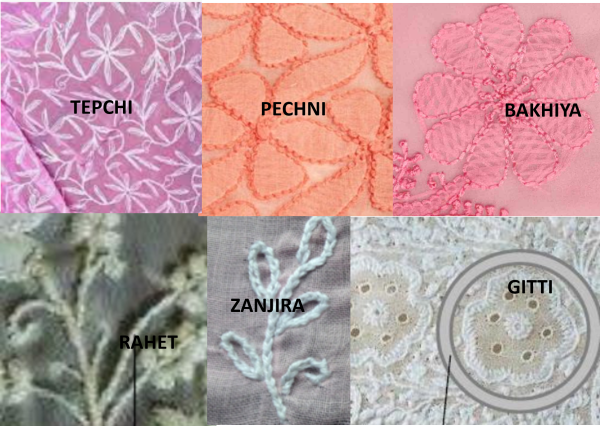
(B) EMBOSSED STITCHES- bolder than flat stitches and have a grainy appearance.
- Murri/Rope Stitch- This tiny satin pear stitch is applied over outlined or already-done tepchi.
- Phanda- This type of stitch, which uses spherical knots, is a condensed version of the Murri This stitch requires a lot of work.
- Ghaas Patti– The grass leaves formed by a V-shaped line of stitches worked in a graduated series on the right side of the fabric. It is occasionally done in parallel rows to fill petals and leaves in a motif.
- Dhum Patti–It is a leaf pattern made of cross-stitch.
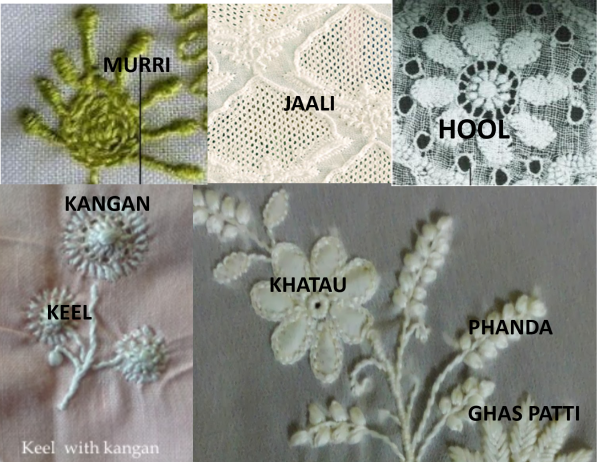
(B) OPEN TRELLIS- stitches that create Net & Holes effect
This stitch is one where the thread is never drawn through the fabric, they are made by teasing the warps and weft yarns apart by needle and holding them in position by small stitches to give it a net effect. This process creates jaalis and regular holes in the fabric.
- Jaali-Jaali stitch is one where the thread is never drawn through the fabric, ensuring that the back portion of the garment looks as impeccable as the front.
- Hool- It is a fine detached eyelet stitch. Here in, a hole is punched in the fabric and the threads are teased apart. It is then held by small straight stitches all around and worked with one thread on the right side of the fabric. Can be worked with six threads and often forms the centre of a flower.
OTHER STITCHES USED IN CHIKANKARI – Bijli, Makra, Kauri, Hathkadi, Banjkali, Sazi, Karan, Madrasi, Taj Mahal, Dhania Patti, Ozan Mehraki
REVIVAL AND CONTEMPORARY ADAPTATIONS
In recent years, Chikankari has experienced a revival, thanks to the efforts of artisans and designers who are reimagining this age-old craft for modern tastes. Contemporary adaptations feature Chikankari on a range of garments, from sarees and salwar suits to fusion wear and accessories, making it accessible to a broader audience while preserving its traditional charm.
CONCLUSION
Chikankari stands as a timeless testament to the skill, creativity, and cultural heritage of India. With its intricate stitches, delicate motifs, and rich legacy, it continues to captivate hearts and inspire admiration worldwide. As we celebrate the artistry of Chikankari, let us also recognize the artisans whose dedication, craftsmanship and artistic sensibilities has preserved this preserved this tradition through generations.
Shop Chikankari Paintings in its various forms at https://craftcrestindia.com/product-category/handloom/

